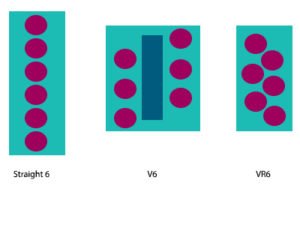The Volkswagon VR6
So you make vehicles with 4 cylinder engines that fit just perfect under the hood, but you want to put in a 6 cylinder engine that fits into the same space. What do you do? 6 cylinder engines are much bigger and you don’t want to have to completely redesign and engineer a new car too. A vee (like a V6) engine takes up too much room and so would a straight 6.

The V in VR6 means just that, a vee. The R means Reihenmotor which, in German means inline. The 6 meaning 6 cylinders. A VR6 engine allows for more displacement which in turn means more power. First introduced in Europe in 1991, the VR6 engine was introduced in the USA the following year, placed in vehicles such as the VW Corrado (a compact sports car) and the VW Passat. There have been 2.8, 2.9, 3.2, and 3.6-liter variations of the VR6 engine.
Here are just of the other vehicles the engine has been used in;
- Volkswagen Golf Mk3/Mk4/Mk5/GTI
- Volkswagen Passat CC/NMS
- VW Touareg
- Volkswagen Atlas (coming soon)
- Porsche Cayenne
- Audi A3/TT/Q7
- Artega GT (look it up…its a pretty nice car)
- Ford Galaxy
- Mercedes-Benz V280
- And are you ready for it……..a Winnebago!
There are lots more but there’s just a few to give you an idea, and surprising they aren’t all German vehicles either.
The most powerful of the engines is the 3.6 FSI VR6 (3,598cc/219 cu in) with DOHC (Double OverHead Cam) puts out between 260-300hp and 260lb-ft of torque.
This engine lays the foundation
Put two VR6 engines side by side and you effectively have the ‘W’ engine. Used in supercars such as Lamborghini’s, Bugatti’s and Bentleys, which are all part of the Volkswagen group.
As far as reliability goes, it good old German engineering at its best. The block has been around for over 10 years and is still being put in production vehicles and even ones that aren’t out yet (VW Atlas).
For a more in-depth look at the engine check out this video:

This is a great blog! Thanks for sharing your knowledge.
Thanks for sharing information in your blog